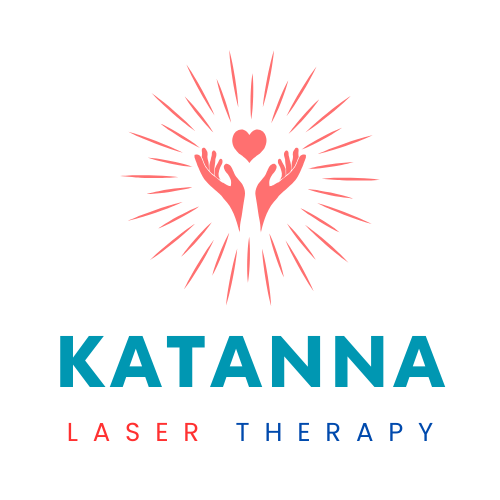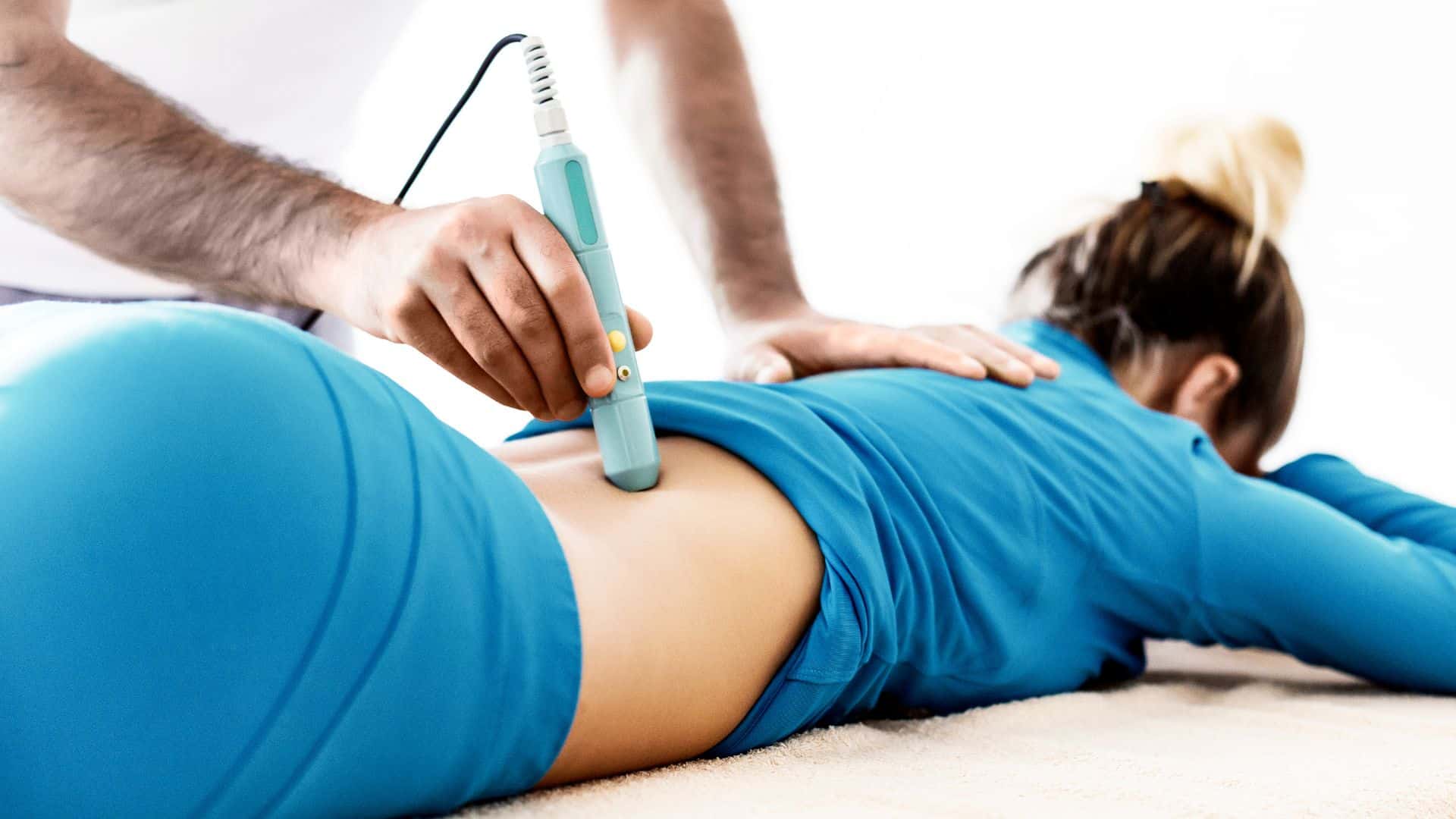Did you know 8 million Canadians live with chronic pain? This shows how important it is to find good pain management solutions. Cold laser therapy, a non-invasive treatment from the 1960s, is a new hope for many.
This method, also known as low-level laser therapy or photobiomodulation, uses light to help heal and lessen pain. It’s effective for many conditions, like knee pain and carpal tunnel syndrome. It’s especially useful for chronic pain, offering hope to those with ongoing discomfort.
We’ll look into how this treatment works, its uses, and why doctors are taking notice. If you’re facing osteoarthritis, fibromyalgia, or sports injuries, cold laser therapy could be your answer.
Key Takeaways
- Cold laser therapy is a non-invasive treatment for various pain conditions
- It uses low-level light energy to promote healing and reduce inflammation
- The therapy can treat conditions like osteoarthritis, back pain, and sports injuries
- Treatment sessions typically last 30-60 seconds per area
- Multiple sessions may be needed for optimal results
- Cold laser therapy is administered by various healthcare professionals
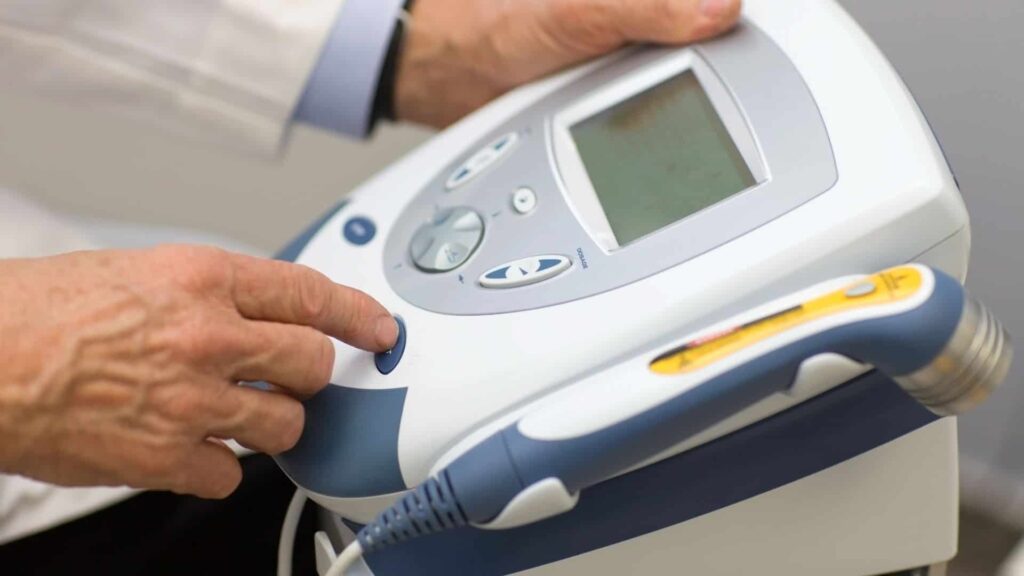
What is Cold Laser Therapy?
Cold laser therapy is a non-invasive way to help cells heal and repair tissues. It has been around for over 40 years, helping people feel better and treat different health issues. This method uses low-level light on the skin. This light goes deep into tissues, starting chemical changes that help heal and grow new cells.
Treatment sessions are quick, taking just a few minutes per spot. It’s painless and focuses on specific areas for the best results. Cold laser therapy helps reduce pain, fight inflammation, heal wounds faster, and boost blood flow in the affected area.
“Cold laser therapy has anti-inflammatory, anti-edema, and analgesic effects that can aid in wound healing,” according to a 2018 research paper.
This treatment has shown great promise in many areas:
- Reducing pain after dental work and orthodontic treatments
- Helping foot ulcers in diabetic patients
- Improving facial recovery in Bell’s palsy cases
- Stimulating hair growth for pattern baldness
Cold laser therapy is becoming more popular as a cost-effective and non-invasive way to ease pain. It’s a natural option that promotes healing without the risks of other treatments.
The Science Behind Cold Laser Therapy
Cold laser therapy, also known as photobiomodulation, boosts cellular processes in the body. It uses light with wavelengths between 400 to 760 nanometers. This light gets absorbed by cells, mainly in the mitochondria.
Karu and Afanas’eva found in 1995 that cytochrome c oxidase is a key player in cells exposed to lasers. This starts a chain of events that changes how cells work. It increases ATP production and controls reactive oxygen species.
A study by Zhang et al. in 2008 showed how low-power lasers affect cells:
- Increased cell growth and movement
- Changes in inflammatory markers
- Release of growth factors and cytokines
This therapy also helps mitochondria work better, boosting energy in cells. Lavi et al. in 2003 discovered that low-energy light creates reactive oxygen species and raises calcium inside cardiac cells.
These changes help heal the body, making cold laser treatment a non-invasive option for many conditions. Treatments usually take about 15 minutes, but can vary by area.
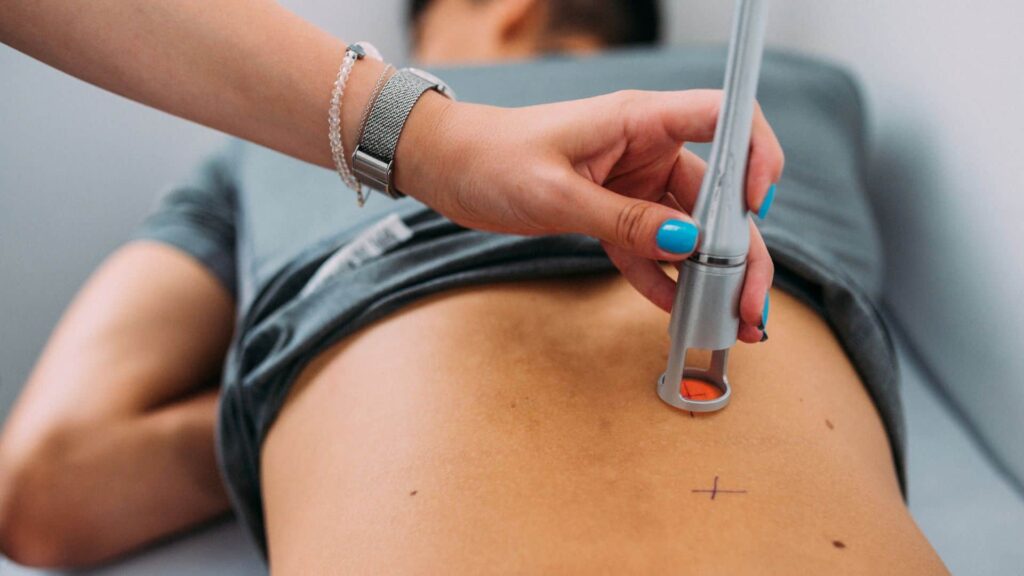
Applications of Cold Laser Therapy in Pain Management
Cold laser therapy is a non-invasive way to manage pain. It helps with musculoskeletal pain, joint pain, neuropathic pain, and sports injuries. Studies show it can lessen pain and help people move better.
For musculoskeletal pain, like osteoarthritis and low back pain, cold laser therapy is helpful. It helps fix cells and lessen swelling. For joint pain, such as rheumatoid arthritis, it reduces pain and helps people move more easily.
Neuropathic pain, including diabetic neuropathy and trigeminal neuralgia, also benefits from cold laser therapy. A study by Falaki et al. (2014) showed it can help with trigeminal neuralgia. This gives hope to those with this tough condition.
- Treats acute and chronic pain
- Addresses arthritis and back pain
- Effective for carpal tunnel syndrome
- Aids in recovery from sports injuries
In sports medicine, laser treatment using cold laser is key for treating injuries and speeding up recovery. It lessens swelling and helps heal muscle strains, ligament sprains, and other injuries faster. This is great for athletes wanting to get back in the game quickly.
“With over 200 clinical studies and in excess of 2,000 published articles, low-level laser therapy has a well-documented research and application history, making it a therapy of choice for difficult pain management challenges.”
Cold laser treatment is becoming more popular as a pain relief option. Its effectiveness and versatility make it a good choice for those looking for alternatives to traditional treatments.
Cold Laser Therapy vs. Traditional Pain Management Methods
Cold laser is a non-drug way to manage pain. A study looked at how it compares to traditional treatments. It had 50 patients, half getting cold laser therapy and the other half traditional treatments.
The study showed big differences. After six hours, those getting cold light beam therapy felt less pain (2.1) than those getting traditional treatments (3.8). This difference was seen at 48 hours too, with cold laser therapy patients feeling almost no pain (0.9).
Cold laser therapy is a good choice if you want to avoid opioids:
- Non-addictive nature
- Minimal side effects
- No drowsiness or constipation
It’s safer than NSAIDs for long-term use. It doesn’t cause stomach ulcers or kidney damage like NSAIDs can.
Physical therapy is key for managing pain. Cold laser therapy can make these treatments work better. Studies show it can speed up healing in sports injuries by up to 50% when used with physical therapy.
“Cold laser therapy has shown an 80% success rate in treating various musculoskeletal conditions, including arthritis and tendonitis.”
While traditional methods are important, cold laser therapy is a non-invasive way to manage pain. It helps cells work better and boosts ATP production by 150%. This makes it effective for healing and reducing pain.
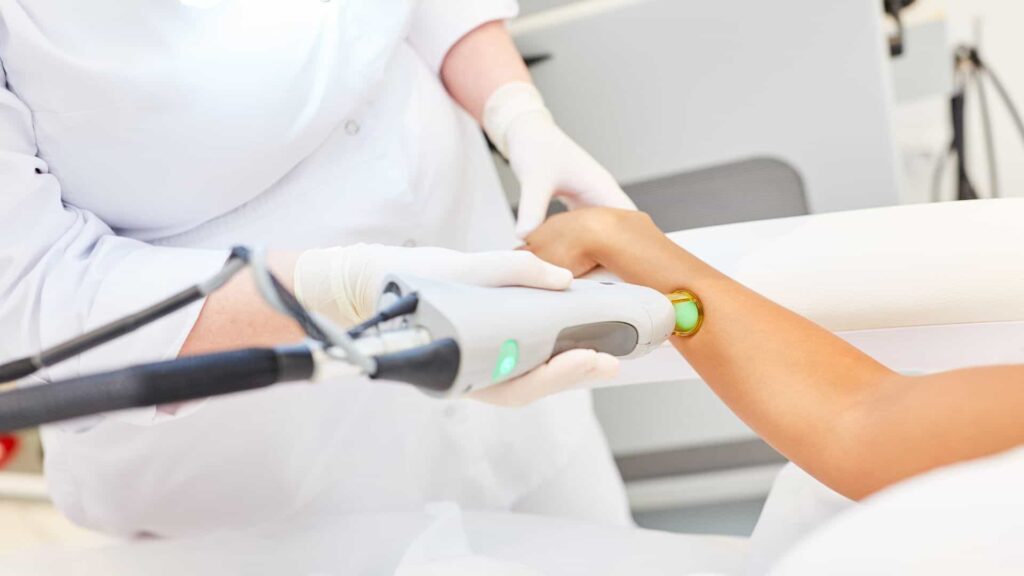
Benefits of Cold Laser Therapy
Cold laser therapy has many benefits for managing pain and healing. It’s a non-invasive treatment that uses low-level infrared light to boost the body’s healing powers. Many Olympic teams and professional athletes use it to reduce pain and recover faster.
This therapy is great for reducing pain. It helps with both chronic and sudden pain, without the need for drugs or surgery. It’s especially good for treating arthritis, fibromyalgia, and lower back pain. People often see better nerve function and feel less pain after treatment.
It’s also great at managing inflammation. The therapy reduces swelling in muscles, ligaments, and joints. This is perfect for treating tendonitis, bursitis, and sports injuries. Plus, it helps improve circulation, which speeds up recovery and lessens muscle soreness.
Cold laser therapy speeds up healing. It boosts cell growth and tissue repair, making the healing process faster. This means quicker recovery times after surgery or injury. It’s also good for treating skin issues and helping wounds heal.
- Treats muscle strains, joint pain, and soft tissue injuries
- Reduces need for medication and surgical intervention
- Improves blood flow in affected areas
- Minimal to no side effects, making it a safe treatment option
“Cold laser therapy is a game-changer in pain management and rehabilitation. It offers effective relief without the risks associated with traditional treatments.”
Cold laser therapy is becoming more popular for pain management and healing in many medical areas. Its versatility and effectiveness make it a top choice.
The Cold Laser Therapy Procedure
Cold laser therapy is a non-invasive treatment that uses light waves to promote healing. A practitioner uses a handheld laser device on the affected area. This device sends out low-level light that goes through the skin without causing heat or damage.
Each session is short, lasting from 30 seconds to several minutes. The exact time depends on the condition and the area’s size. Most people need several sessions to get the best results. These sessions can be from 8 to 30, over several weeks.
Here’s what you can expect during a cold laser therapy session:
- You’ll be asked to lie down or sit comfortably
- The practitioner will place the laser device directly on or close to your skin
- You might feel a slight tingling sensation, but no pain
- The session ends once the predetermined therapy duration is reached
Every patient’s treatment is unique. The light dose, intensity, and frequency are adjusted for the condition. This ensures the most effective treatment for each person.
“Cold laser therapy is a safe, painless procedure that can be completed in just minutes,” notes Dr. Sarah Thompson, a leading physiotherapist in Toronto.
While cold laser therapy is generally safe, it’s important to get it from a qualified practitioner. They can set up the right treatment plan and make sure it’s done correctly.
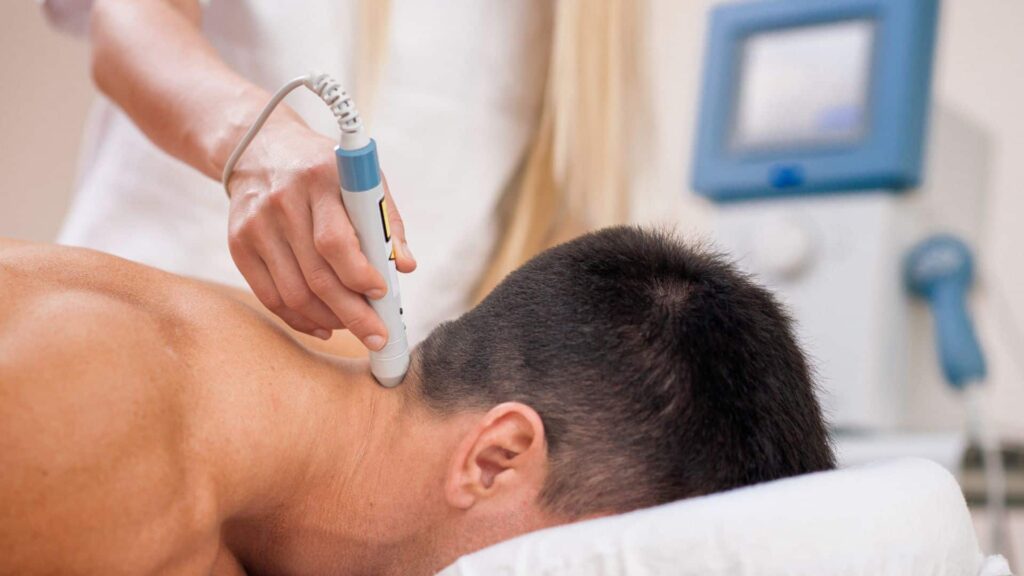
Effectiveness of Cold Laser Therapy in Different Body Areas
Cold laser therapy helps with knee pain, especially for those with osteoarthritis. Studies show it can reduce pain and help people move better. This therapy uses low-power lasers to treat knee pain.
People with back pain may also find relief with cold laser therapy. A 2015 study found it helped lower back pain. In one study, 62 people got laser treatment on their lower back and hips. This led to a 49% drop in pain without needing more treatments.
Cold laser therapy is also good for neck pain, especially for those with chronic issues. It helps with shoulder pain, including rotator cuff injuries and frozen shoulder. For hand and wrist pain, like carpal tunnel syndrome, it can make a big difference.
“Low-level laser therapy is an effective, safe, and well-tolerated treatment for fibromyalgia,” according to a recent meta-analysis.
Many people feel better after just three to five sessions. But some might need up to 20 treatments for the best results. The cost is between $75 to $100 per session, and insurance often doesn’t cover it.
- Knee pain: Effective for osteoarthritis
- Back pain: Positive results in reducing low back pain
- Neck pain: Beneficial for chronic conditions
- Shoulder pain: Helpful for various shoulder injuries
- Hand and wrist pain: Improvement noted in carpal tunnel syndrome
Cold Laser Therapy for Specific Conditions
Cold laser therapy is a non-invasive treatment that uses low-level light to help heal and reduce pain. It’s effective for many health issues. Let’s look at how it helps with specific conditions.
For osteoarthritis, cold laser therapy is a big help. It cuts down on pain and makes joints work better, especially in knees. People often move more easily and feel less pain after a few treatments.
Fibromyalgia is tough to manage, but cold laser can ease the pain. It helps lessen widespread pain and makes life better. Regular treatments can lead to fewer tender spots and better sleep.
Athletes and those who stay active find cold laser therapy great for tendinitis. It lowers inflammation and helps heal tendons. It works well for tennis elbow or Achilles tendinitis.
“Cold laser therapy has been a game-changer for my patients with chronic tendinitis. They report faster recovery times and less pain during activities,” shares Dr. Emily Chen, a sports medicine specialist.
Cold laser therapy is also great for wound healing. It speeds up healing for wounds, even diabetic ones. The therapy boosts cell activity, makes more collagen, and improves blood flow to the wound.
- Reduces inflammation in arthritic joints
- Alleviates widespread pain in fibromyalgia
- Promotes faster healing of tendons
- Accelerates wound closure and reduces infection risk
Studies show cold laser therapy can help in just 3-5 treatments. But, it might take up to 30 sessions for full recovery. For ongoing issues, you might need treatments every 1-3 months.
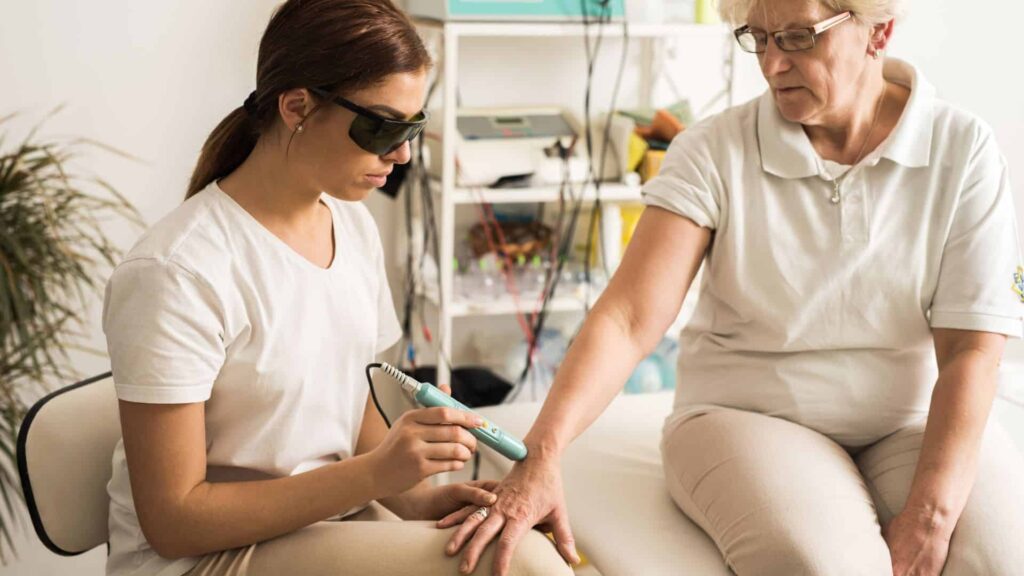
Potential Risks and Contraindications
treatment using cold laser has many benefits, but it’s not without risks. People with epilepsy should not use it because it can increase seizure risks. It’s important to wear eye protection during treatments to avoid eye damage from the laser.
Some might feel more pain or get tired right after the first few treatments.
Pregnant women should not have cold laser therapy because we don’t know how it affects the baby. People with cancer should talk to their doctor before trying it. Those with blood clotting problems or weakened immune systems should be careful too.
“NEVER treat a known or suspected cancer or tumor without approval from an oncologist or primary physician.”
Most side effects are mild and don’t happen often. A study by Enwemeka et al. (2004) found it helped with healing and pain. But, Schwartzberg and Gold (2020) pointed out issues with cosmetic lasers, showing the importance of being careful.
- Avoid treating areas with recent sun exposure or sunburn
- Do not use over pacemakers or internal electronics
- Suspend therapy if unusual reactions occur
Cold laser therapy is usually safe, but knowing the risks helps make sure it works well and keeps patients safe.
Integrating Cold Laser Therapy with Other Treatments
Cold laser therapy is a key tool in managing pain. It works well with other treatments for a strong therapy mix. This mix helps heal faster and covers many health issues.
Chiropractic care and cold laser therapy make a great team. They help with musculoskeletal problems. The laser therapy eases inflammation and relaxes muscles first. Then, chiropractic care can work better on the improved tissues.
This team-up brings big benefits:
- Enhanced joint function
- Reduced pain levels
- Improved range of motion
- Faster recovery times
- Better overall quality of life
Cold laser therapy also pairs well with other treatments. It boosts the effects of physical therapy. In sports medicine, it helps heal injuries faster with other methods. Some even mix it with acupuncture or massage for a full wellness plan.
“The synergy of cold laser and chiropractic treatments optimizes the body’s response to therapy by increasing blood flow and ensuring proper alignment.”
This mix of treatments shows how versatile cold laser therapy is. It fits into many treatment plans, giving patients a personalized way to get better. As research goes on, we might find even more ways to use this technology in care plans.
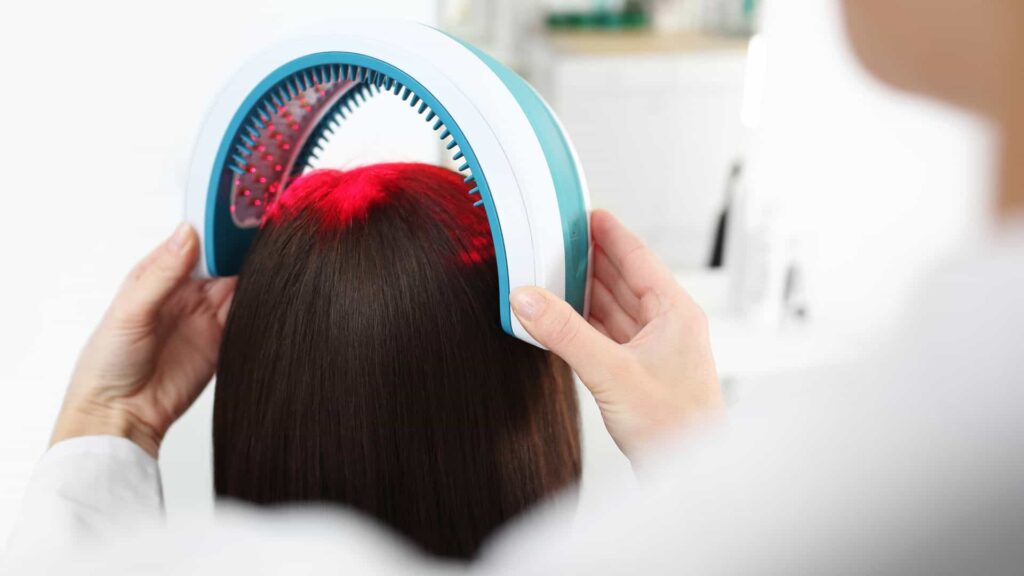
Future Developments in Cold Laser Therapy
Cold laser therapy is growing fast, thanks to new research. Domer Technology has brought out two new lasers. One is a Class 3B cold laser for therapy, and the other is a powerful Class 4 Laser. This Class 4 laser cuts treatment time to just 5-10 minutes, making it more efficient and comfortable for patients.
New tech is making cold laser therapy useful for more than just pain relief. It could help with neurodegenerative diseases like Alzheimer’s and dementia. It’s also being tested for metabolic disorders, diabetic nerve damage, and some cancers.
The future of cold laser therapy is exciting, with new uses in sports medicine and beauty treatments. Researchers are looking into how it can help with chronic inflammation and speed up wound healing. These findings could change how we treat everything from tendonitis to skin infections.
“Low-level laser therapy stimulates healing and reduces pain in chronic pain management, nociceptive pain reduction, and weight loss.”
As studies prove cold laser therapy is safe and effective, it’s becoming a common treatment. We can expect to see more in the future, like:
- Personalized treatment plans based on genetic profiles
- Integration of artificial intelligence to optimize therapy parameters
- Improved delivery methods for enhanced effectiveness and accessibility
- Combination therapies with hyperbaric oxygen and nutritional strategies
These advancements could make cold laser therapy a key, non-drug option for many health issues. It could lessen the need for painkillers and lead to better health outcomes for patients.
Conclusion
Cold laser therapy is a promising way to manage pain without surgery. Studies show it helps with many health issues. For example, a 2003 review looked at 88 studies and found it can lessen pain. Another study in 2012 showed it worked well with exercises for Achilles’ tendinopathy.
This therapy has helped people with chronic back pain, as seen in a 2003 study by Gur et al. It also helped those with rheumatoid arthritis, making their hands work better, as found by Meireles et al. in 2010. Cold laser therapy is also good for treating plantar fasciitis and carpal tunnel syndrome, offering a way to avoid drugs.
Even though cold laser therapy looks promising, it often needs several treatments to work. Patients should talk to their doctors about using it in their pain treatment plan. As research and technology get better, cold laser therapy is set to become a key part of treating pain without surgery.
